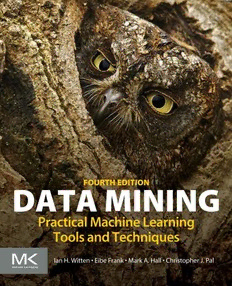Table Of ContentData Mining
This pageintentionallyleftblank
Data Mining
Practical Machine Learning
Tools and Techniques
Fourth Edition
Ian H. Witten
University of Waikato, Hamilton, New Zealand
Eibe Frank
University of Waikato, Hamilton, New Zealand
Mark A. Hall
University of Waikato, Hamilton, New Zealand
Christopher J. Pal
Polytechnique Montre´al, and the Universite´ de Montre´al,
Montreal, QC, Canada
AMSTERDAM(cid:129)BOSTON(cid:129)HEIDELBERG(cid:129)LONDON
NEWYORK(cid:129)OXFORD(cid:129)PARIS(cid:129)SANDIEGO
SANFRANCISCO(cid:129)SINGAPORE(cid:129)SYDNEY(cid:129)TOKYO
MorganKaufmannisanimprintofElsevier
MorganKaufmannisanimprintofElsevier
50HampshireStreet,5thFloor,Cambridge,MA02139,UnitedStates
Copyright©2017,2011,2005,2000ElsevierInc.Allrightsreserved.
Nopartofthispublicationmaybereproducedortransmittedinanyformorbyanymeans,electronic
ormechanical,includingphotocopying,recording,oranyinformationstorageandretrievalsystem,
withoutpermissioninwritingfromthepublisher.Detailsonhowtoseekpermission,further
informationaboutthePublisher’spermissionspoliciesandourarrangementswithorganizations
suchastheCopyrightClearanceCenterandtheCopyrightLicensingAgency,canbefoundatour
website:www.elsevier.com/permissions.
Thisbookandtheindividualcontributionscontainedinitareprotectedundercopyrightbythe
Publisher(otherthanasmaybenotedherein).
Notices
Knowledgeandbestpracticeinthisfieldareconstantlychanging.Asnewresearchandexperience
broadenourunderstanding,changesinresearchmethods,professionalpractices,ormedicaltreatment
maybecomenecessary.
Practitionersandresearchersmustalwaysrelyontheirownexperienceandknowledgeinevaluating
andusinganyinformation,methods,compounds,orexperimentsdescribedherein.Inusingsuch
informationormethodstheyshouldbemindfuloftheirownsafetyandthesafetyofothers,including
partiesforwhomtheyhaveaprofessionalresponsibility.
Tothefullestextentofthelaw,neitherthePublishernortheauthors,contributors,oreditors,assume
anyliabilityforanyinjuryand/ordamagetopersonsorpropertyasamatterofproductsliability,
negligenceorotherwise,orfromanyuseoroperationofanymethods,products,instructions,orideas
containedinthematerialherein.
BritishLibraryCataloguing-in-PublicationData
AcataloguerecordforthisbookisavailablefromtheBritishLibrary
LibraryofCongressCataloging-in-PublicationData
AcatalogrecordforthisbookisavailablefromtheLibraryofCongress
ISBN:978-0-12-804291-5
ForInformationonallMorganKaufmannpublications
visitourwebsiteathttps://www.elsevier.com
Publisher:ToddGreen
AcquisitionEditor:TimPitts
EditorialProjectManager:CharlotteKent
ProductionProjectManager:NickyCarter
Designer:MatthewLimbert
TypesetbyMPSLimited,Chennai,India
Contents
List ofFigures..........................................................................................................xv
List ofTables..........................................................................................................xxi
Preface.................................................................................................................xxiii
PART I INTRODUCTION TO DATA MINING
CHAPTER 1 What’s it all about?..........................................................3
1.1 Data Miningand Machine Learning..............................................4
Describing Structural Patterns.......................................................6
Machine Learning..........................................................................7
Data Mining...................................................................................9
1.2 Simple Examples: The Weather Problem and Others...................9
TheWeather Problem..................................................................10
Contact Lenses:An Idealized Problem.......................................12
Irises:AClassic Numeric Dataset..............................................14
CPU Performance:IntroducingNumeric Prediction..................16
LaborNegotiations: AMore Realistic Example.........................16
Soybean Classification: A Classic Machine Learning
Success...................................................................................19
1.3 Fielded Applications....................................................................21
Web Mining.................................................................................21
Decisions Involving Judgment....................................................22
Screening Images.........................................................................23
LoadForecasting.........................................................................24
Diagnosis......................................................................................25
Marketing andSales....................................................................26
Other Applications.......................................................................27
1.4 TheData Mining Process.............................................................28
1.5 Machine Learningand Statistics..................................................30
1.6 Generalization as Search..............................................................31
Enumeratingthe Concept Space.................................................32
Bias..............................................................................................33
1.7 Data Miningand Ethics...............................................................35
Reidentification............................................................................36
Using Personal Information.........................................................37
Wider Issues.................................................................................38
1.8 Further Reading andBibliographicNotes...................................38
v
vi Contents
CHAPTER 2 Input: concepts, instances, attributes.........................43
2.1 What’s aConcept?.......................................................................44
2.2 What’s inanExample?................................................................46
Relations......................................................................................47
Other Example Types..................................................................51
2.3 What’s inanAttribute?................................................................53
2.4 Preparing the Input.......................................................................56
Gatheringthe Data Together.......................................................56
ARFF Format...............................................................................57
Sparse Data..................................................................................60
Attribute Types............................................................................61
Missing Values............................................................................62
Inaccurate Values.........................................................................63
Unbalanced Data..........................................................................64
Getting to Know Your Data........................................................65
2.5 Further Reading and Bibliographic Notes...................................65
CHAPTER 3 Output: knowledge representation...............................67
3.1 Tables...........................................................................................68
3.2 Linear Models..............................................................................68
3.3 Trees.............................................................................................70
3.4 Rules.............................................................................................75
Classification Rules.....................................................................75
AssociationRules........................................................................79
Rules With Exceptions................................................................80
More Expressive Rules................................................................82
3.5 Instance-Based Representation....................................................84
3.6 Clusters.........................................................................................87
3.7 Further Reading and Bibliographic Notes...................................88
CHAPTER 4 Algorithms: the basic methods.....................................91
4.1 InferringRudimentary Rules.......................................................93
Missing Values andNumeric Attributes.....................................94
4.2 Simple ProbabilisticModeling....................................................96
Missing Values andNumeric Attributes...................................100
Na¨ıveBayes for Document Classification................................103
Remarks.....................................................................................105
4.3 Divide-and-Conquer: Constructing DecisionTrees..................105
Calculating Information.............................................................108
Highly BranchingAttributes.....................................................110
Contents vii
4.4 Covering Algorithms:Constructing Rules..............................113
Rules Versus Trees..................................................................114
ASimple Covering Algorithm................................................115
Rules Versus DecisionLists....................................................119
4.5 MiningAssociation Rules........................................................120
Item Sets..................................................................................120
Association Rules....................................................................122
Generating Rules Efficiently...................................................124
4.6 LinearModels..........................................................................128
Numeric Prediction:LinearRegression..................................128
Linear Classification: LogisticRegression.............................129
Linear Classification Using the Perceptron............................131
Linear Classification Using Winnow......................................133
4.7 Instance-BasedLearning..........................................................135
The Distance Function.............................................................135
Finding NearestNeighborsEfficiently...................................136
Remarks...................................................................................141
4.8 Clustering.................................................................................141
IterativeDistance-Based Clustering........................................142
Faster Distance Calculations...................................................144
Choosing the Number of Clusters...........................................146
Hierarchical Clustering............................................................147
Example ofHierarchical Clustering........................................148
Incremental Clustering.............................................................150
CategoryUtility.......................................................................154
Remarks...................................................................................156
4.9 Multi-instance Learning...........................................................156
Aggregating the Input..............................................................157
Aggregating the Output...........................................................157
4.10 Further Reading and BibliographicNotes...............................158
4.11 WEKA Implementations..........................................................160
CHAPTER 5 Credibility: evaluating what’s been learned.............161
5.1 Training and Testing..................................................................163
5.2 Predicting Performance..............................................................165
5.3 Cross-Validation.........................................................................167
5.4 Other Estimates..........................................................................169
Leave-One-Out..........................................................................169
TheBootstrap.............................................................................169
5.5 Hyperparameter Selection..........................................................171
viii Contents
5.6 ComparingData Mining Schemes...........................................172
5.7 Predicting Probabilities............................................................176
Quadratic Loss Function..........................................................177
InformationalLoss Function...................................................178
Remarks...................................................................................179
5.8 Counting the Cost....................................................................179
Cost-Sensitive Classification...................................................182
Cost-Sensitive Learning...........................................................183
Lift Charts................................................................................183
ROC Curves.............................................................................186
Recall-PrecisionCurves...........................................................190
Remarks...................................................................................190
CostCurves..............................................................................192
5.9 Evaluating Numeric Prediction...............................................194
5.10 The MDL Principle..................................................................197
5.11 Applying the MDL Principle toClustering.............................200
5.12 Using aValidation Set for Model Selection...........................201
5.13 Further Readingand Bibliographic Notes...............................202
PART II MORE ADVANCED MACHINE LEARNING SCHEMES
CHAPTER 6 Trees and rules.............................................................209
6.1 DecisionTrees............................................................................210
Numeric Attributes....................................................................210
Missing Values..........................................................................212
Pruning.......................................................................................213
Estimating Error Rates..............................................................215
ComplexityofDecisionTree Induction....................................217
From Trees toRules..................................................................219
C4.5:Choices andOptions........................................................219
Cost-ComplexityPruning..........................................................220
Discussion..................................................................................221
6.2 Classification Rules....................................................................221
Criteria for Choosing Tests.......................................................222
Missing Values, Numeric Attributes.........................................223
GeneratingGood Rules.............................................................224
Using Global Optimization........................................................226
ObtainingRules From PartialDecisionTrees..........................227
Rules With Exceptions..............................................................231
Discussion..................................................................................233
Contents ix
6.3 AssociationRules.......................................................................234
Building a Frequent Pattern Tree..............................................235
FindingLarge Item Sets............................................................240
Discussion..................................................................................241
6.4 WEKA Implementations............................................................242
CHAPTER 7 Extending instance-based and linear models..........243
7.1 Instance-Based Learning............................................................244
Reducing the Number of Exemplars.........................................245
Pruning Noisy Exemplars..........................................................245
Weighting Attributes.................................................................246
GeneralizingExemplars.............................................................247
Distance Functions for Generalized Exemplars........................248
Generalized Distance Functions................................................250
Discussion..................................................................................250
7.2 Extending Linear Models...........................................................252
TheMaximumMarginHyperplane...........................................253
Nonlinear Class Boundaries......................................................254
Support Vector Regression........................................................256
Kernel Ridge Regression...........................................................258
TheKernel Perceptron...............................................................260
Multilayer Perceptrons...............................................................261
RadialBasisFunction Networks...............................................270
Stochastic Gradient Descent......................................................270
Discussion..................................................................................272
7.3 Numeric Prediction With Local LinearModels........................273
Model Trees...............................................................................274
Building the Tree.......................................................................275
Pruning the Tree........................................................................275
NominalAttributes....................................................................276
Missing Values..........................................................................276
Pseudocode for Model Tree Induction......................................277
Rules From Model Trees...........................................................281
Locally Weighted Linear Regression........................................281
Discussion..................................................................................283
7.4 WEKA Implementations............................................................284
CHAPTER 8 Data transformations....................................................285
8.1 Attribute Selection.....................................................................288
Scheme-Independent Selection..................................................289
Searching the Attribute Space...................................................292
Scheme-Specific Selection........................................................293

